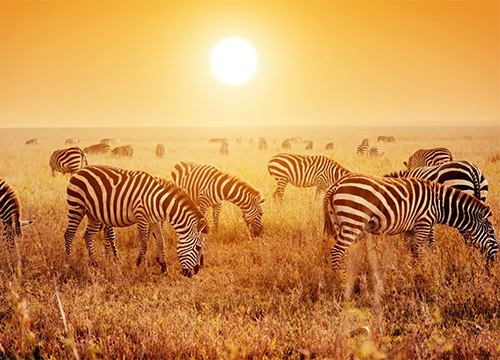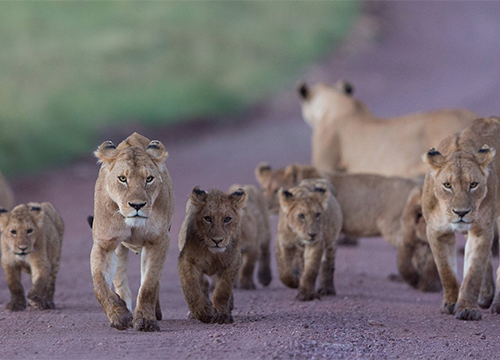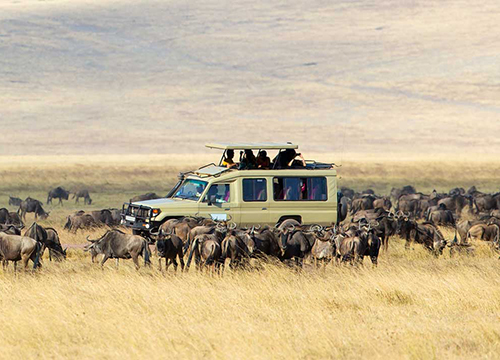
Tour Overview
Explore the Ngorongoro Crater, a UNESCO World Heritage Site, known for its dense wildlife population within the confines of an ancient volcanic caldera. Continue to Tarangire National Park, renowned for its colossal elephant herds and scenic landscapes. Each day brings thrilling game drives, providing opportunities to witness the diverse fauna that defines Tanzania’s remarkable safari experiences.
With carefully selected accommodations, this 7-day safari promises an immersive and unforgettable exploration of Tanzania’s natural wonders and wildlife-rich landscapes.
7 Days Best Of Tanzania Safaris (Serengeti National Park – Ngorongoro Crater - Tarangire National Park)
Day 1: Sirare border – Serengeti National Park
Pick up will be Sirare border and drive towards Serengeti with packed lunches from Kenya. The National Park, with an area of 12,950 square kilometres, is as big as Northern Ireland and is roughly the size of Kuwait. As such it offers the most complex and least disturbed ecosystem on earth. A unique combination of diverse habitats enables it to support more than 30 species of large harbivores and nearly 500 species of birds. In the open grass plains during the rainy months from November to May hundreds of thousands of wildebeest and Burchell’s zebra congregate. En route, we will do game drive in this vast plain of Serengeti arriving just before dusk at our camp near Seronera river.
Day 2: Serengeti National Park
After breakfast, we depart for a morning game drive in this magnificent national park. Our drive will include the search for leopards, lions, cheetah, hippos and many other animals that will be happy to welcome us to their kingdom. We carry packed lunch in order to make the best of the day. Serengeti National Park is undoubtedly the best-known wildlife sanctuary in the world, unequalled for its natural beauty and scientific value. With more than two million wildebeest, half a million Thomson’s gazelle, and a quarter of a million zebra, it has the greatest concentration of plains game in Africa. The wildebeest and zebra moreover form the star cast of a unique spectacular – the annual Serengeti migration. The name ‘Serengeti’ comes from the Maasai language and appropriately means an ‘extended place’. The Serengeti’s climate is usually warm and dry. The main rainy season is from March to May, with short rains falling from October to November. Dinner and overnight at the camp.
Day 3: Serengeti National Park – Ngorongoro Crater
Today we depart for an early morning game drive which will allow us to have a chance to see the cats hunting for their breakfast since they habitually spend most of the hot hours of the day sleeping and lazing around evading the hot sun. We return to our lodge for breakfast before driving to Ngorongoro via Olduvai Gorge which is considered as the origin of mankind; this is where the famous doctor leakey and his family discovered the fossils of the Australopithecus Boisei. The dramatic landscape of the Ngorongoro Highlands is the perfect complement to the flatness of the Serengeti. Populated by Maasai tribes, this area of grasslands, volcanoes and forests makes utterly superb hiking terrain. Our drive will include searching for the rhino, elephants, hippos, cheetah, wildbeest, lions and plentiful of other predators and their prey. We arrive at our lodge situated on the crater rim just in time for lunch. The rest of the afternoon can be spent at leisure having spectacular views of the crater. Dinner and overnight at simba camp site.
Day 4: Ngorongoro Crater
Just after breakfast, we descend into the crater floor for a half day crater tour. Ngorongoro Crater is a complete ecosystem and considered as the eight wonder of the world. Ngorongoro is found in the “Land of the Giant Craters.” This caldera is 14 miles (22.5 km) across at its widest point. It is 2000 ft (610 m) deep. It grew to be this large by sinking of the caldera floor. The caldera floor is very level and holds a lake. Streams run down the caldera walls into the lake. Ngorongoro is full of pastureland of red and white clover. Over 75,000 wild animals live in this caldera., Our drive will include searching for the rhino, elephants, hippos, cheetah, wildbeest, lions and plentiful of other predators and their prey. We return to our lodge for a delicious lunch before driving to a nearby maasai village where we will happily enjoy the maasai culture and livelihood. We return to the lodge just before dusk. Dinner and overnight at the camp.
Day 5: Ngorongoro Crater – Tarangire National Park
After breakfast, we depart towards Tarangire with game viewing en route to our lodge. After lunch, we continue with game drives. Tarangire National Park covers approximately 2600 square kilometers and, in the dry season, is second only to Ngorongoro Crater Conservation Area in concentrations of wildlife. Tarangire lies to the south of the large, open grass plains of southern Maasailand, and derives its name from the Tarangire River, which provides permanent water for wildlife in the area. The park is spectacular in the dry season when many of the migratory wildlife species come back to the permanent waters of Tarangire River. Huge herds of wildebeest, zebras, elephants, eland and oryx gather to stay in Tarangire until the onset of the rains when they migrate. Tarangire national park never disappoint you as there plenty of native elephant, lions, rarely seen lesser kudu, bushbuck, baboons and the incredible tree climbing pythons. Dinner and overnight at the camp.
Day 6: Tarangire National Park
Today we depart for a full day game drive in this magnificent park. Tarangire National Park covers approximately 2600 square kilometers and, in the dry season, is second only to Ngorongoro Crater Conservation Area in concentrations of wildlife. Tarangire lies to the south of the large, open grass plains of southern Maasailand, and derives its name from the Tarangire River, which provides permanent water for wildlife in the area. The park is spectacular in the dry season when many of the migratory wildlife species come back to the permanent waters of Tarangire River. Huge herds of wildebeest, zebras, elephants, eland and oryx gather to stay in Tarangire until the onset of the rains when they migrate. All meals and overnight stay at a camp
Day 7: Arusha
Pre-breakfast game drive for 2hrs. Back to the camp for full breakfast and later depart for Arusha.



